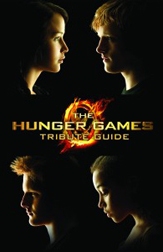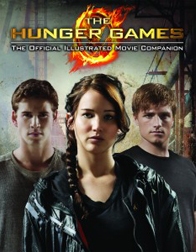Building Momentum for The Hunger Games
As the countdown to Katniss continues, Lionsgate has been rolling out a deliberate marketing strategy to build momentum ahead of the first movie. Some steps, like a Super Bowl commercial and the world premiere of Taylor Swift’s music video on MTV, are designed to get word about The Hunger Games in front of as many eyes as possible. Other moves, like image teasers on Facebook and links to third-party news and pop culture reports on Twitter, help generate excitement among fans already paying close attention and keep word of mouth building with enthusiasm.
Likewise, even though Scholastic is raking in money hand over fist with skyrocketing sales of the three novels as the movie approaches – reportedly including 7.5 million copies just in the two months after the first trailer’s release – the publisher is wisely not sitting back and resting on the laurels provided by Lionsgate’s film. Instead, Scholastic is publishing additional tie-in books for The Hunger Games, creating a fantastic opportunity not only for more print sales, but also for more excitement for the movie.
This synergy between the efforts of Scholastic and Lionsgate is designed to generate a snowball effect of fan enthusiasm, with each of the partners benefitting the other to their mutual benefit. So far, these efforts at building the brand have been impressive and effective. We’ll find out even more this week, on Wednesday, February 22, when presale tickets for opening day go on sale. The higher the presale figures climb, the louder the buzz will grow.
In the meantime, fans of The Hunger Games should definitely consider picking up the first two tie-in books from Scholastic. Like the novels, they’re written for a young-adult audience and make fast reads for adults. (The third tie-in, The World of The Hunger Games, doesn’t go on sale until the same day as the movie due to its high spoiler content, including the much-anticipated first ever official map of Panem and its Districts.)
The Tribute Guide, as the title suggests, focuses on the competitors and their path from Reaping to the start of the 74th Games. What makes the book especially fun – and chilling – is that the author, Emily Seife, writes it from a disturbingly believable in-universe perspective. The novels, seen through Katniss’ eyes, only show bits and pieces of the Capitol propaganda about the Games, such as the television reports and the dialogue from characters like Effie Trinket and Caeaser Flickerman. Picking up on the tone and word choice of those moments, Seife spins out an entire guide to the competition and its combatants. (As an aside: Coming from the Star Wars fandom, where every single background detail gets a name, designation, and backstory, I actually found it refreshing that the Tribute Guide doesn’t give names for all 24 tributes, but rather only the ones named in the books; the others are simply Tribute Boy or Tribute Girl.) This book reminds me of reading one of those game programs hawked by vendors at a sports stadium in our world – except its teenagers fighting to the death, and we’re told their honored and excited to be there. It sent chills down my spine.
 The Official Illustrated Movie Companion also is true to its title, and in format and layout it’s similar to guides of this style for other movies. The book moves chronologically through the movie’s creation, from Suzanne Collins’ novels to the hiring of producer Nina Jacobson and director Gary Ross, then to casting, design (of sets, costumes, and props), and finally filming the movie. Photographs fill the pages, including publicity images and candids as well as behind-the-scenes glimpses; the vast majority of these are newly revealed in this book. Interestingly, the book studiously avoids images from the Games themselves, keeping its visual preview limited to District 12, the Capitol, and the preparations for the Games. This makes for a very effective teaser strategy – even diehard fans who’ve followed every bit of promotional material for the movie, and who’ve acquired a good sense of the visual aesthetic of District 12 or the Capitol, are walking into the theater with just as much a sense of anticipating the unexpected about the Games as most members of the audience will have about the whole movie.
The Official Illustrated Movie Companion also is true to its title, and in format and layout it’s similar to guides of this style for other movies. The book moves chronologically through the movie’s creation, from Suzanne Collins’ novels to the hiring of producer Nina Jacobson and director Gary Ross, then to casting, design (of sets, costumes, and props), and finally filming the movie. Photographs fill the pages, including publicity images and candids as well as behind-the-scenes glimpses; the vast majority of these are newly revealed in this book. Interestingly, the book studiously avoids images from the Games themselves, keeping its visual preview limited to District 12, the Capitol, and the preparations for the Games. This makes for a very effective teaser strategy – even diehard fans who’ve followed every bit of promotional material for the movie, and who’ve acquired a good sense of the visual aesthetic of District 12 or the Capitol, are walking into the theater with just as much a sense of anticipating the unexpected about the Games as most members of the audience will have about the whole movie.
What impressed me most about the Official Illustrated Movie Companion, though, wasn’t the images from the film, although they’re fantastic – it was how strongly the passion of the film’s creators came across in the book’s prose sections, written by Collins’ editor at Scholastic, Kate Egan. At every step of the process, from writing the script and casting the actors to furnishing the Everdeen home to weapons training, it’s obvious that everyone working on the film wanted to get it right. (Even if, along the way, they had to deal with snakes, bears, and North Carolina downpours – apparently the Hunger Games equivalent of the Tunisian sandstorms that plagued Star Wars movie shoots two decades apart.) With so many Hollywood projects seemingly slapped together just to make a movie, it’s reassuring to realize that everyone involved in making The Hunger Games cares just as deeply about the character, setting, and story as the fans, and that they’re committed to making it the very best movie it can possibly be.
- BJ Priester Talks The Acolyte Episode 6 on Who’s the Bossk? - July 7, 2024
- Dave Filoni Talks Writing AHSOKA and Guiding the Future of Star Wars Storytelling - June 21, 2024
- Lessons in Franchise Management – MCU: The Reign of Marvel Studios - January 14, 2024











Pingback:Journey of a Strong Female Heroine: Katniss Everdeen « fangirlblog.com